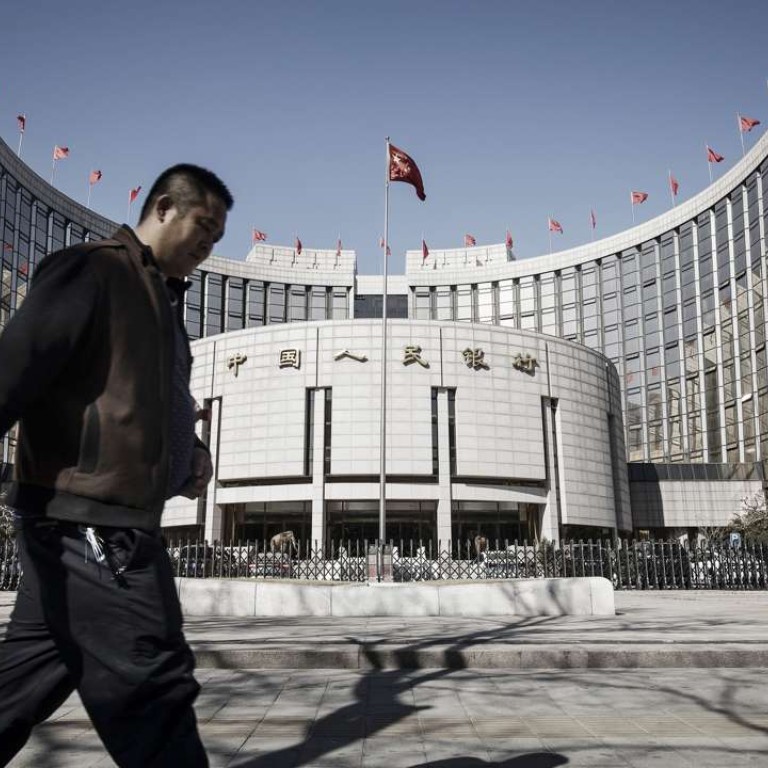
Shadow banking makes a surprise return to China
Borrowers are turning to risky deals because they cannot obtain financing through credit channels, analysts say
A surprisingly rebound of shadow banking credit was recorded in the mainland in the first quarter of this year, despite efforts by the central bank to curb off-balance activities.
It reflected the difficulty for the People’s Bank of China to strike a balance between two sometimes conflicting policy goals –tightening monetary policy to control financial risk while ensuring a sufficient supply of credit to keep growth on track.
A rise in shadow banking activities is a sign that many borrowers are turning to murky and risky deals because they cannot obtain financing through regular bank loans or bonds, analysts said. This could undermine Beijing’s efforts to root out financial risks later this year when a key communist power reshuffle takes place.

The size of China’s aggregate financing, which measures overall financing support to economic activities via various form of credit, was up 3.4 per cent from a year earlier to 6.93 trillion yuan (US$1 trillion) in the first three months of this year, according to data released by the central bank on Friday.
Broken down, off-balance sheet bank credit saw rapid growth in the first quarter. Trust loans grew by nearly four times to 734.9 billion yuan, entrusted loans – organised by agents between borrowers and lenders – advanced by 15.7 per cent to 634.7 billion yuan, while bankers acceptances (short-term credit investments created by a non-financial firm and guaranteed by a bank to make payment) surged by 900.5 billion yuan compared with last year.
As such activities often contain high risks, Chinese central bank governor Zhou Xiaochuan introduced a so-called macro prudential assessment (MPA) system, comprised of dozens of indicators, to encourage banks to put all credit activities on their books, instead of hiding them.
“The efforts to push non-standard investments back to the banks’ balance sheet can’t be achieved in the short term given such restrictions as capital adequacy ratio requirement,” said Wen Bin, chief analyst at China Minsheng Banking Corp.
Many mainland companies face cash flow problems as banks turn more cautious in the face of growing non-performing loans.They have refused to roll over loans when they fall due or adjust the size since China’s economic growth dropped to a 26-year low of 6.7 per cent in 2016.
Companies’ direct fund-raising channels have been affected in recent months. January to March corporate bond sales declined by 1.5 trillion yuan from a year earlier after interest rates rose and tighter regulatory oversight was introduced at the end of last year. Equity finance, will remaining small, grew 3.8 per cent year-on-year to 294.8 billion yuan in the first quarter.

“The primary goal of the MPA policy is to prevent a further increase of financial leverage and eliminate related financial risks, rather than kill Chinese firms,” said Wen at Minsheng Bank. “The MPA mechanism will improve gradually with more focus on tightening capital and leverage.”
PBOC spokesman Ruan Jianhong also admitted in a statement that the rise of total financing scale aggregate financing and medium- and long-term corporate loans was used to support domestic firms.
Many private firms rely heavily on off-balance sheet channels, including private lending, to maintain operations, despite the much higher financing costs compare with state-owned enterprises.
Only a few small banks, which introduced a wide range of wealth management products over the past several years to boost their size, had some trouble in meeting MPA criteria. The interbank money rate, a sign of market liquidity, remained generally stable at the end of March.
E Yongjian, an analyst at Bank of Communications in Shanghai, said that the spike in shadow banking activities might not be sustained in coming quarters.
“The financial regulators have not yet unified asset management standards. But when they do, it will rein in off-balance sheet activities,” he said.
The standards have been deliberated by major financial regulators since February, aiming to crack down regulatory arbitrage and tackle growing risks embedded in increasing mixed financial operations in China.
New bank loans decreased by 385.6 billion yuan to 4.22 trillion yuan in January-March, as the financial regulators sent “window guidance” to curb the rapid expansion of mortgages in line with the nationwide property tightening policy.
The proportion of medium- and long-term household loans, equivalent to mortgages, in new loans fell by 10.3 percentage points to 34.6 per cent by the end of March.

